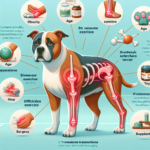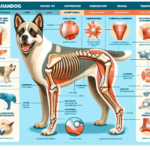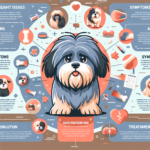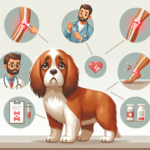Newfoundland Joint Pain: Causes, Symptoms, Prevention, and Treatment
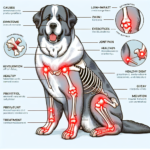
Introduction
The Newfoundland dog, often affectionately referred to as the “Newfie,” is a large working breed known for its gentle temperament, strength, and swimming prowess. Originating from the Canadian island of Newfoundland, these dogs were initially bred to assist fishermen, pulling nets and rescuing those who fell overboard. Their thick, water-resistant coat, webbed feet, and powerful build make them excellent swimmers. Newfoundlands are also known for their loyalty, intelligence, and calm demeanor, making them wonderful family pets.
While Newfoundlands are generally healthy dogs, they are prone to certain health issues due to their size and genetics. One of the most significant concerns for this breed is joint pain, which can severely impact their quality of life. Joint health is particularly crucial for Newfoundlands because their large size places additional stress on their joints, making them more susceptible to conditions like hip dysplasia and arthritis.
Breed-Specific Joint Pain Risks
Genetic Predisposition
Newfoundlands have a genetic predisposition to several joint-related issues. Hip dysplasia, a condition where the hip joint doesn’t fit properly into the hip socket, is particularly common in this breed. This can lead to arthritis and significant pain over time. Elbow dysplasia, another hereditary condition, affects the elbow joints and can cause lameness and discomfort. These genetic factors make it essential for breeders to screen for these conditions to reduce their prevalence in future generations.
Age-Related Risks
As Newfoundlands age, the risk of developing joint pain increases. The breed typically reaches senior status around 6-7 years old, and it’s during these years that joint issues often become more apparent. Owners should be vigilant about monitoring their dog’s mobility and comfort levels as they age, as early detection can lead to more effective management of joint pain.
Activity Level and Joint Stress
Newfoundlands are known for their working capabilities and high activity levels, especially in water-related tasks. While regular exercise is essential for their overall health, excessive or inappropriate activities can place undue stress on their joints. Activities that involve jumping or sudden changes in direction can be particularly harmful. It’s crucial to balance their need for exercise with activities that are gentle on their joints.
Common Symptoms of Joint Pain in Newfoundlands
General Symptoms
- Limping: One of the most noticeable signs of joint pain is limping or favoring one leg over another.
- Stiffness: Dogs may show stiffness, especially after resting or sleeping.
- Reluctance to Move: A dog in pain may be hesitant to climb stairs, jump into the car, or even go for walks.
- Decreased Activity: A reduction in overall activity levels can indicate discomfort.
- Behavioral Changes: Irritability or changes in behavior can also be signs of pain.
Breed-Specific Symptoms
In Newfoundlands, symptoms of joint pain may be more pronounced due to their size. Owners might notice a reluctance to engage in activities they once enjoyed, such as swimming or playing fetch. Additionally, the breed’s heavy build can make it more challenging to detect subtle signs of discomfort, so close observation is essential.
When to Consult a Vet
If you notice any of the above symptoms, it’s crucial to consult a veterinarian promptly. Early intervention can significantly improve the prognosis and quality of life for a dog suffering from joint pain. Regular veterinary check-ups are also essential for early detection and management of joint issues.
Preventive Measures for Joint Health
Exercise Recommendations
Regular, low-impact exercise is vital for maintaining joint health in Newfoundlands. Swimming is an excellent option as it provides a full-body workout without placing stress on the joints. Gentle walks and controlled play sessions are also beneficial. Avoid activities that involve jumping or sudden changes in direction, as these can exacerbate joint issues.
Dietary Suggestions
A balanced diet rich in essential nutrients can support joint health. Look for dog foods that contain glucosamine and chondroitin, which are known to promote joint health. Omega-3 fatty acids, found in fish oil, can also help reduce inflammation. Consult your veterinarian for specific dietary recommendations tailored to your dog’s needs.
Weight Management
Maintaining a healthy weight is crucial for reducing joint stress. Excess weight can exacerbate joint pain and lead to other health issues. Monitor your dog’s weight regularly and adjust their diet and exercise routine as needed. Your veterinarian can provide guidance on the ideal weight range for your Newfoundland.
Early Screening and Monitoring
Early screening for joint issues can help catch problems before they become severe. Regular veterinary check-ups should include joint assessments, especially as your dog ages. Genetic testing can also identify predispositions to conditions like hip and elbow dysplasia, allowing for early intervention and management.
Treatment Options for Joint Pain
Non-Surgical Treatments
Non-surgical treatments are often the first line of defense against joint pain. These can include:
- Medications: Anti-inflammatory drugs and pain relievers can help manage symptoms.
- Physical Therapy: Specialized exercises can strengthen muscles and improve joint function.
- Lifestyle Adjustments: Modifying your dog’s activity levels and environment can reduce joint stress.
Surgical Options
If non-surgical treatments are ineffective, surgical interventions may be necessary. Common surgeries for joint pain in Newfoundlands include:
- Hip Replacement: This surgery replaces the damaged hip joint with an artificial one.
- Elbow Surgery: Procedures to remove bone fragments or realign the joint can alleviate pain.
- Arthroscopy: A minimally invasive surgery to clean out the joint and remove damaged tissue.
Alternative Therapies
Alternative therapies can complement traditional treatments and provide additional relief. These may include:
- Acupuncture: This ancient practice can help reduce pain and improve mobility.
- Hydrotherapy: Water-based exercises can strengthen muscles without stressing the joints.
- Massage: Regular massages can improve circulation and reduce muscle tension.
Lifestyle and Management Tips
Daily Care Routine
A consistent daily care routine can help manage joint pain in Newfoundlands. This might include:
- Gentle morning walks to loosen stiff joints.
- Regular, low-impact play sessions.
- Administering any prescribed medications or supplements.
- Providing a balanced diet rich in joint-supporting nutrients.
Modifying the Home Environment
Making your home more comfortable for a dog with joint pain can significantly improve their quality of life. Consider the following modifications:
- Ramps: Install ramps to help your dog navigate stairs or get into the car.
- Orthopedic Beds: Provide a supportive bed to reduce pressure on joints.
- Non-Slip Flooring: Ensure your floors are non-slip to prevent falls and injuries.
Long-Term Management
Long-term management of joint pain involves a combination of regular veterinary care, appropriate exercise, and a supportive home environment. Consistent monitoring and adjustments to your dog’s care routine can help them remain active and happy despite joint issues.
FAQs About Newfoundlands and Joint Pain
What are the early signs of joint pain in Newfoundlands?
Early signs include limping, stiffness, reluctance to move, and decreased activity levels. Behavioral changes such as irritability may also indicate discomfort.
Can joint pain in Newfoundlands be prevented?
While genetic predispositions can’t be entirely prevented, maintaining a healthy weight, providing appropriate exercise, and regular veterinary check-ups can significantly reduce the risk and severity of joint pain.
Are there specific diets that can help with joint health?
Yes, diets rich in glucosamine, chondroitin, and omega-3 fatty acids can support joint health. Consult your veterinarian for specific dietary recommendations.
When should I consider surgery for my dog’s joint pain?
Surgery should be considered if non-surgical treatments are ineffective and your dog’s quality of life is significantly impacted. Consult your veterinarian for a thorough evaluation and recommendations.
What are some alternative therapies for managing joint pain?
Alternative therapies such as acupuncture, hydrotherapy, and massage can complement traditional treatments and provide additional relief.
Conclusion
Joint pain is a significant concern for Newfoundland dogs due to their size and genetic predispositions. Early detection, preventive measures, and appropriate treatments can help manage this condition effectively. Regular veterinary check-ups, a balanced diet, and a supportive home environment are crucial for maintaining your Newfoundland’s joint health. By taking proactive steps, you can ensure your dog remains active, happy, and comfortable throughout their life.

